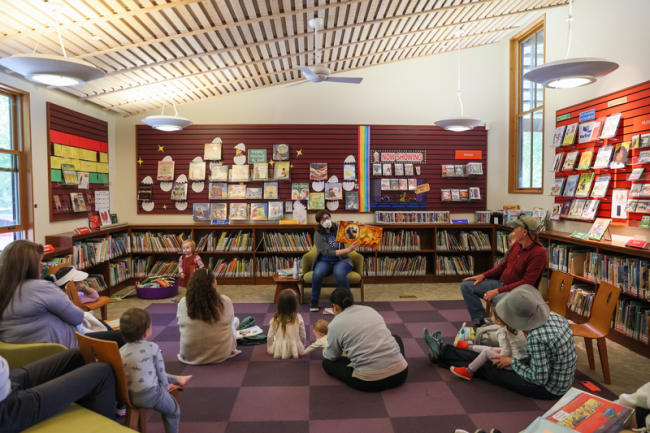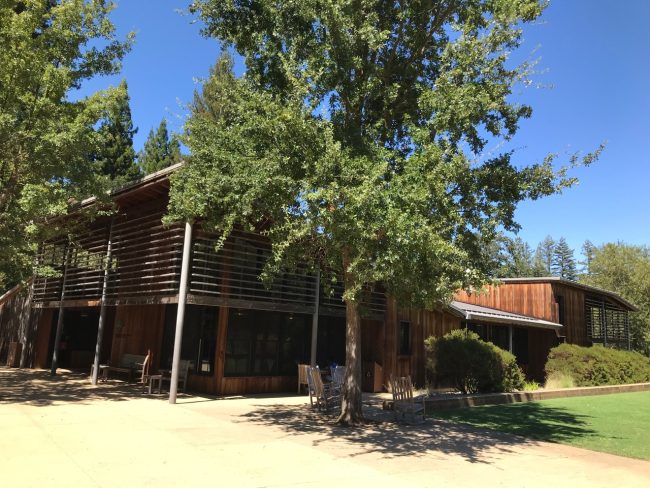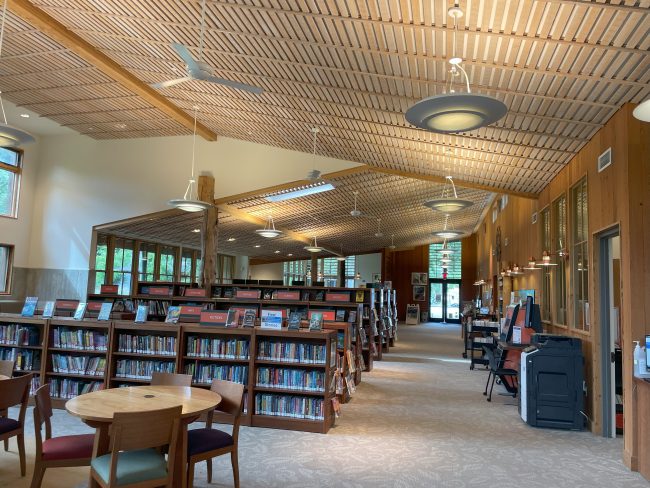WALKABOUT #3: The Portola Valley Library (August 31, 2024)
WALKABOUT #3: The Portola Valley Library (August 31, 2024)
Agile Aging readers may remember my new Walkabout series of posts, designed to meet and celebrate interesting neighbors near our Northern California retirement community. (See the March 31, 2024 post for the most recent example.)
This month I became better acquainted with the Portola Valley Library, a mile’s walk from our campus. Libraries have always attracted and delighted me, from paneled college reading rooms to Andrew Carnegie legacies up and down California. On this occasion I was impressed and encouraged by our local library’s evident qualities: dedicated leadership and services, high energy and expanding activities. A grassroots dynamo addressing transitional challenges.
I’d like to share with you some Walkabout highlights.
LUMBER AND LIGHT
You can tell quite a lot about an institution’s values and priorities by examining its physical plant. The Portola Valley Library was designed and erected in the first decade of the 21st century as part of a three-component new town center (along with a town hall and community hall). Great attention was paid by its two Emeryville architectural firms to making full use of natural materials and natural light. Ninety percent of lumber salvaged from a disassembled adjacent schoolhouse was repurposed for town-center construction. Hand-crafted furniture used sustainably harvested solid wood. The structures were sited to preserve foreground vistas of redwood groves, a restored creek and open space against a background ridge of Santa Cruz Mountains. Private town residents raised and donated most of the $16-million capital funding. The eco-friendly Library building and operating systems earned top-rated LEED certification (Leadership in Energy & Environmental Design.)
MINDING THE STORE
Thanks to kindly facilitation by friend and neighbor Kajsa Tabor, I was able to introduce myself to the Library’s two presiding professionals: Branch Manager Carmen Letona-Adams and Librarian Jeneen Nammar. Both these individuals earned Master’s degrees in Library & Information Science. Both worked for years in local libraries, in part as children’s librarians, before assuming their present positions. They currently divide their time between Portola Valley and Woodside libraries (the neighboring town just to our north.) Carmen focuses on program administration and budgeting, staff supervision and training. Jeneen concentrates on delivery of client services, community outreach and maintenance of the libraries’ collected books, music and videos. (The Portola Valley collection contains 20,000 items.)
The twinned libraries remain open seven days a week, from 10am to 8pm on weekdays, to 5pm on weekends. In addition to my two hosts, Portola Valley’s paid staff includes a Senior Librarian currently on family leave, two Community Program Assistants, three Library Assistants and a flexible number of library aides. Despite their heavy workload, Carmen and Jeneen were consistently courteous and patient in answering my in-person and emailed questions.
In our half-dozen candid exchanges, I was struck by their spontaneous enthusiasm and high motivation. In passing, they referred me to their organization’s mission statement and commitment to transformative learning, “supporting life journeys of patrons.” But individually and separately, they each emphasized the “joy” of being a librarian. I could not help contrasting this zest with current national statistics: a substantial majority of all American workers either dislike or loathe their jobs.
Carmen described her two key management goals as inspiring a new generation of readers and mentoring multilingual staff. Second-language skills enhance her team’s service to an increasingly diverse, more inclusive clientele. (Six percent of Portola Valley residents speak Spanish at home; two percent, Mandarin Chinese or Japanese.)
As we came to know each other better, I commented to Carmen that her characterizations of Portola Valley Library operations seemed one-dimensionally affirmative. She replied that she wasn’t being hypocritical; in the present period, she finds herself without serious managerial concerns or problems. She added that public libraries nationwide are in fact confronting a major threat: state and local initiatives to censor or ban “objectionable” books. Thankfully, that culture-war assault has not invaded Portola Valley.
By coincidence, I had an opportunity to observe Jeneen conducting a workshop at our retirement community, demystifying for seniors how to use the internet for library-book borrowing. She was obviously proficient and comfortable with audiovisual technology, pulling up PowerPoint images with a remote device and her laptop. But she was also playful, while tacitly inviting her audience to give change a chance. In my experience, techies and entertainers seldom occupy the same body.
INSTITUTIONAL ARRANGEMENTS
Over the course of our rolling dialogue, my guides helped me understand and appreciate Portola Valley Library’s somewhat complicated institutional relationships. It’s a unit of the San Mateo County Government, funded by County property taxes. Its staff are County employees. It has close and cordial working relationships with the surrounding Portola Valley town government, but has no formal ties. Under a Joint Powers Agreement, the Library is a member of a consortium of 13 small local libraries, rather confusingly labeled “The San Mateo County Libraries.” In fact this dozen is only a subset of a larger San Mateo County grouping, the 35-member Peninsula Library System. (The latter network includes large-city and community-college libraries.) The reason these affiliations are important and invaluable is that they allow Portola Valley librarians to promptly summon books from a vast geographical area to respond to their local clients’ requests.
STEERING THROUGH DISRUPTIVE TRANSITIONS
Carmen explained that the Library has been coping with overlapping interruptions. COVID in particular hammered the provision of services. Walk-ins virtually halted. Clients couldn’t even stop by to pick up books on hold. Adult, student and younger-child contacts shriveled. She was dismayed by all these age groups’ “broken reading habits.” Only now are service numbers bouncing back to pre-pandemic levels.
The transition from traditional hard-copy borrowing to electronic communication has had a more mixed impact. On the positive side, internet connectivity can be a direct antidote for pandemic separations. No-contact communication, searches and borrowing can keep many library functions operating. E-books can be transmitted with a few keystrokes. Effective remote learning requires remote book-borrowing. Jeneen illustrated that a pre-COVID author’s presentation of a new work would have attracted a one-room, in-person Library audience. Anti-pandemic collaboration with County schools could enable the Library to bump that number up to a Zoom collective of 500 to 2,000 viewing students.
On the other hand, senior clients – a major segment of the Portola Valley Library’s potential client base – remain partly intimidated by digital communication, especially of the self-help variety. For example, I noticed when Jeneen was cheerfully promoting seniors’ use of apps on cell phones to facilitate individuals’ access to book-borrowing, more than a few resistant residents spoke up in protest. “Palo Alto Library does it for me.” “I just want a book; not a computer seminar.” And I confess I could see their point. While I consider myself an enthusiastic client of the Library, what I most marvel at is the system’s ability to locate and procure a desired book for me, all with my simple phone call. (Free delivery to our retirement community is a bonus.) So while technology is updating and upgrading library services, with young clients effortlessly keeping pace, many elders lack the skills and self-confidence to take full advantage of these innovations. And in fairness to resisters, many may simply prefer not to invest in mastering new technologies, with the mortality clock ticking.
WHO ARE YOU SERVING?
I asked Carmen if she could help me gain a clearer impression of her Portola Valley Library client base. She replied that a majority of users live or work in the town. Adults and children split about 50/50.
She walked me through a typical day of service:
- In the morning, the main activities are facilitated reading sessions (“Storytimes”) for infants, preschoolers, primary school students and their parents.
- By mid-day, prime users include local non-profit groups that welcome complimentary Library space for their meetings. Adult meetings might include art and crafting workshops, book groups and guest-author presentations.
- By mid-afternoon, high-school students start drifting in for quiet homework space, appointments with tutors and simple social rendezvous on the shaded terraces.
- Late afternoons and evenings are dominated by after-work adults, picking up book-holds or lingering for quiet reading.
 Jeneen explained that Storytimes are appreciated by the parents of even infants. Child psychology has confirmed that letting babies listen to out-loud stories in a comfortable setting builds attention-span as well as positive associations and expectations between pleasure and reading. These impressions in turn can enhance young children’s preparation for pre-school, plus enthusiasm for starting their own reading. Not incidentally, Storytime facilitators can also demonstrate for young parents how inserting story-character voices, sound effects and facial expressions can elevate “mere” reading to entertaining performances for their offspring.
Jeneen explained that Storytimes are appreciated by the parents of even infants. Child psychology has confirmed that letting babies listen to out-loud stories in a comfortable setting builds attention-span as well as positive associations and expectations between pleasure and reading. These impressions in turn can enhance young children’s preparation for pre-school, plus enthusiasm for starting their own reading. Not incidentally, Storytime facilitators can also demonstrate for young parents how inserting story-character voices, sound effects and facial expressions can elevate “mere” reading to entertaining performances for their offspring.
Carmen surprised me by emphasizing that she aspires to develop the Library as a “safe and welcoming space” for all these age-groups. I questioned her use of “safe” in a privileged enclave like Portola Valley. She clarified that she mostly meant “quiet and private” respite from at-home sibling chaos. But she diplomatically added that high-income households are not immune from family violence and conflicts.
EXPANDING THE TENT
When I survey the ambitious scope of Portola Valley Library resources, services and activities, I have difficulty recognizing my concept of a traditional library. In my childhood and student days, libraries were fundamentally conservative: staid repositories of books and periodicals, combined with severely monitored reading rooms. At Portola Valley Library, there is a collection of materials, a lending service and a team of trained reference librarians. But the expanding menu of activities encompasses tai chi classes, and an end-of-summer circus and magic show for students about to return to school. Volunteer Friends of the Library raise funds to support this recreation. (Carmen emphasized that the broad slate of activities is demand-driven, not promoted by an institution laboring to avoid obsolescence. The circus show attracted 160 attendees.)
Even more diverse is the inventory of resources, what Jeneen described as “The Library of Things.” Many of these items are learning tools for gratis lending to clients, including laptops and portable hotspots for Wi-Fi connectivity. But the list extends to hiking poles and backpacks, donated by the State Department of Parks and Recreation. (The motivation for the latter gifts is to provide basic outdoor equipment to less prosperous visitors keen to enjoy Portola Valley’s easy access to nature.)
I come away from my Walkabout with the impression that Portola Valley Library is evolving into a multifaceted “Community Recharging Station.” And that community embraces outsiders. Perhaps in past eras in other towns, lead roles for providing comparable support may have been taken by schools, churches, NGOs and charitable institutions. In our serene sanctuary, the local library is stepping up to offer an oasis of hope for those in need.
My sincere thanks to Carmen Letona-Adams and Jeneen Nammar for their gracious Walkabout hospitality.
Thanks also to Carmen and to Nancy Swing for the use of their photos.
Blog Readers, let me hear from you: rbs@agileaging.net .



